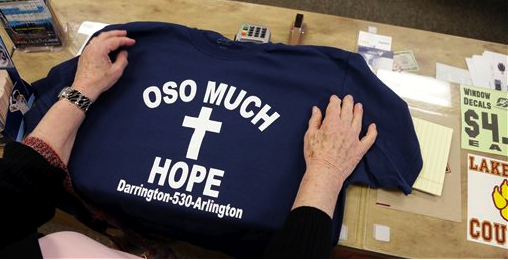By JONATHAN J. COOPER and MATT VOLZ
The Associated Press
EDITOR’S NOTE — A list with photos of known victims of the mile-wide mudslide near Oso — persons confirmed missing or dead by authorities or families — can be accessed at http://seattletimes.com/flatpages/local/victimsoftheosomudslide.html
Related story: “Snohomish County mudslide — how to donate to victims, how to report someone missing”: https://www.peninsuladailynews.com/article/20140328/NEWS/303289959
ARLINGTON — Authorities all but abandoned hope Friday of finding survivors under tons of twisted, sodden earth as the Snohomish County rural community of Oso waited in anguish to learn the full scope of what is already one of the most devastating landslides in U.S. history.
The grueling process of locating, extracting and identifying human remains from the unstable debris in Oso has slowed the release of information by the Snohomish County Medical Examiner’s Office to a trickle.
Crews may be finding more remains amid the destruction, but the official death toll will remain at 17 until medical examiners can complete the “very, very challenging” task of identifying the bodies, said Snohomish County Executive Director Gary Haakenson.
Authorities have located at least eight other bodies in addition to the 17, for a total of 26 dead, and they previously said they expect the number of fatalities from Saturday’s mudslide to rise substantially.
Ninety people were listed as missing, but hope for them began fading by midweek when they had not checked in with friends or relatives, and no one had emerged from the pile alive.
“We always want to hold out hope, but I think at some point we have to expect the worst,” Haaksenson said.
Leslie Zylstra said everybody in town knows someone who died, and Oso was coming to grips with the fact that many of the missing may remain entombed in the debris.
“The people know there’s no way anybody could have survived,” said Zylstra, who used to work in an Arlington hardware store. “They just want to have their loved ones, to bury their loved ones.”
Haakenson described for the first time Friday the difficulty of the searchers’ task.
When a body is found, the spot is marked for a helicopter pickup.
That only happens when the helicopters are able to fly in the wind and rain that has pummeled the search area.
The victim is then placed in a truck in a holding area.
At the end of the day, all the recovered victims are transported to the medical examiner’s office about 20 miles away in Everett.
“Autopsies are performed, the process of identification takes place — if possible,” Haakenson said.
“The identification process has been very, very challenging. Once identified, we send a chaplain to the family, to notify them of our findings.”
In addition to bearing the stress of the disaster, townspeople were increasingly frustrated by the lack of information from authorities, said Mary Schoenfeldt, a disaster traumatologist who has been providing counseling services at schools and for public employees and volunteers.
“The anger and frustration is starting to rise,” she said.
That’s normal for this phase of a disaster, as is the physical toll taken by not having eaten or slept normally in days, she said.
There were also signs of resilience. Handmade signs have appeared that say “Oso strong” and “530 pride” in reference to the stricken community and state Highway 530 that runs through it.
The catastrophe, which followed weeks of heavy rain, was shaping up to be one of the state’s worst disasters and one of the deadliest mudslides in U.S. history.
The 1980 eruption of Mount St. Helens killed 57 people and a 1910 avalanche near Stevens Pass that swept away two trains killed 96.
Previous slides triggered by storms included one that killed 150 people in Virginia in the wake of Hurricane Camille in 1969 and another that killed 129 when rain from Tropical
Storm Isabel loosened tons of mud that buried the Puerto Rican community of Mameyes in 1985.
A dam in San Francisquito, Calif., collapsed in 1928, causing an abutment to give way and killing 500 people, according to data from the U.S. Geological Survey.
Rescuers, military personnel, volunteers and search dogs pressed on Friday, driven by the hope of finding at least one survivor. But the operation had changed, said Snohomish County fire battalion commander Steve Mason.
“It started with hasty searching,” he said. Now “we want to be more methodical.”
Crews that had worked for days in the rain and mud were getting some relief as replacements arrived. The Colorado National Guard sent 16 members of its fatality search-and-recovery team to Washington.
A new crew of volunteer diggers showed up in an Arlington school bus Friday and marched single file toward the debris pile.
“There are people down here digging for their loved ones,” Mason said.
The county medical examiner’s office has so far formally identified five victims: Christina Jefferds, 45, of Arlington; Stephen A. Neal, 55, of Darrington; Linda L. McPherson, 69, of Arlington; Kaylee B. Spillers, 5, of Arlington and William E. Welsh, 66, of Arlington.
The body of Jefferds’ granddaughter, 4-month-old Sanoah Huestis, was found Thursday, said Dale Petersen, the girl’s great-uncle.

